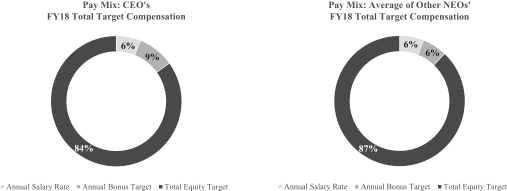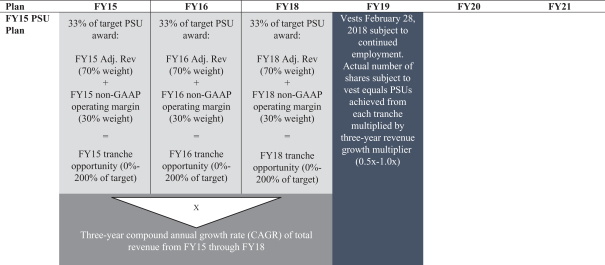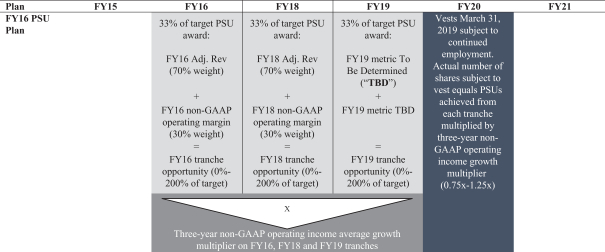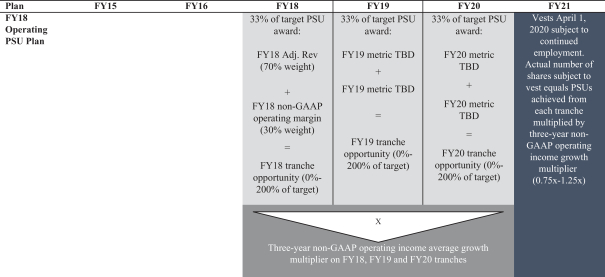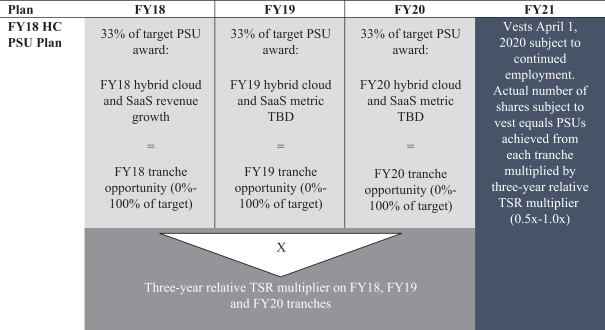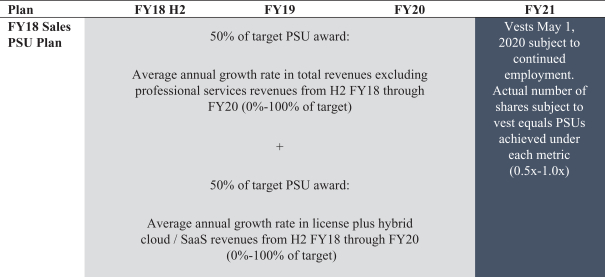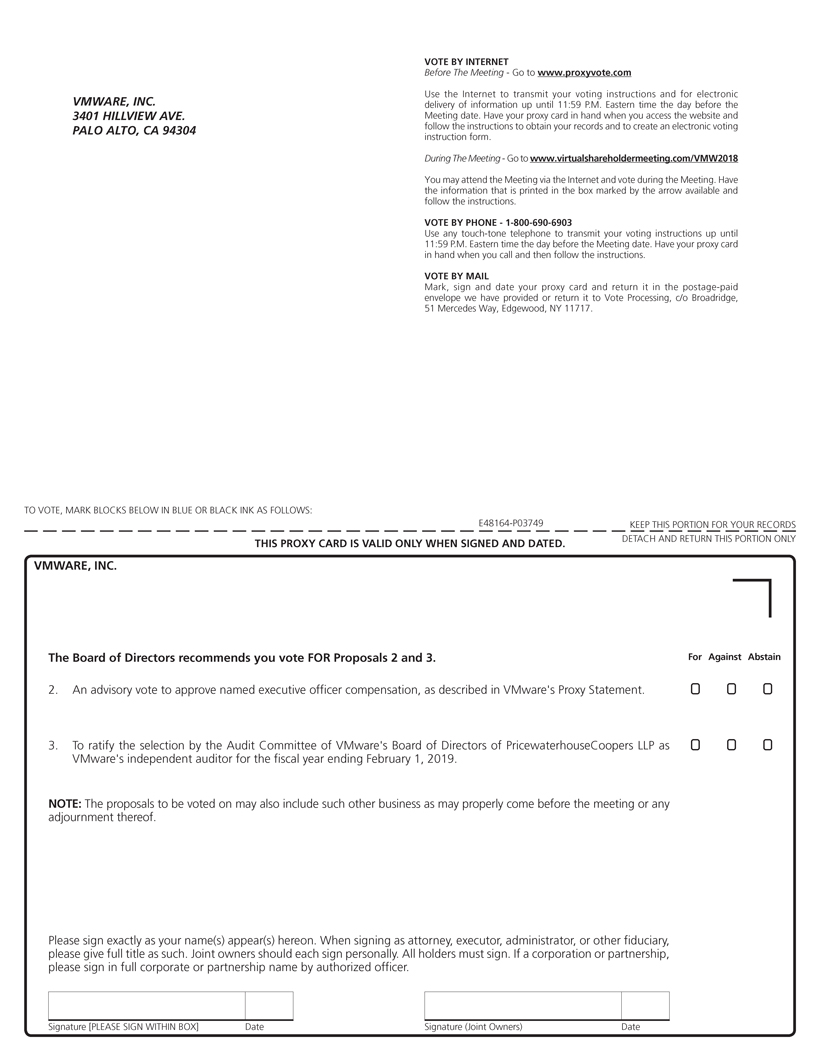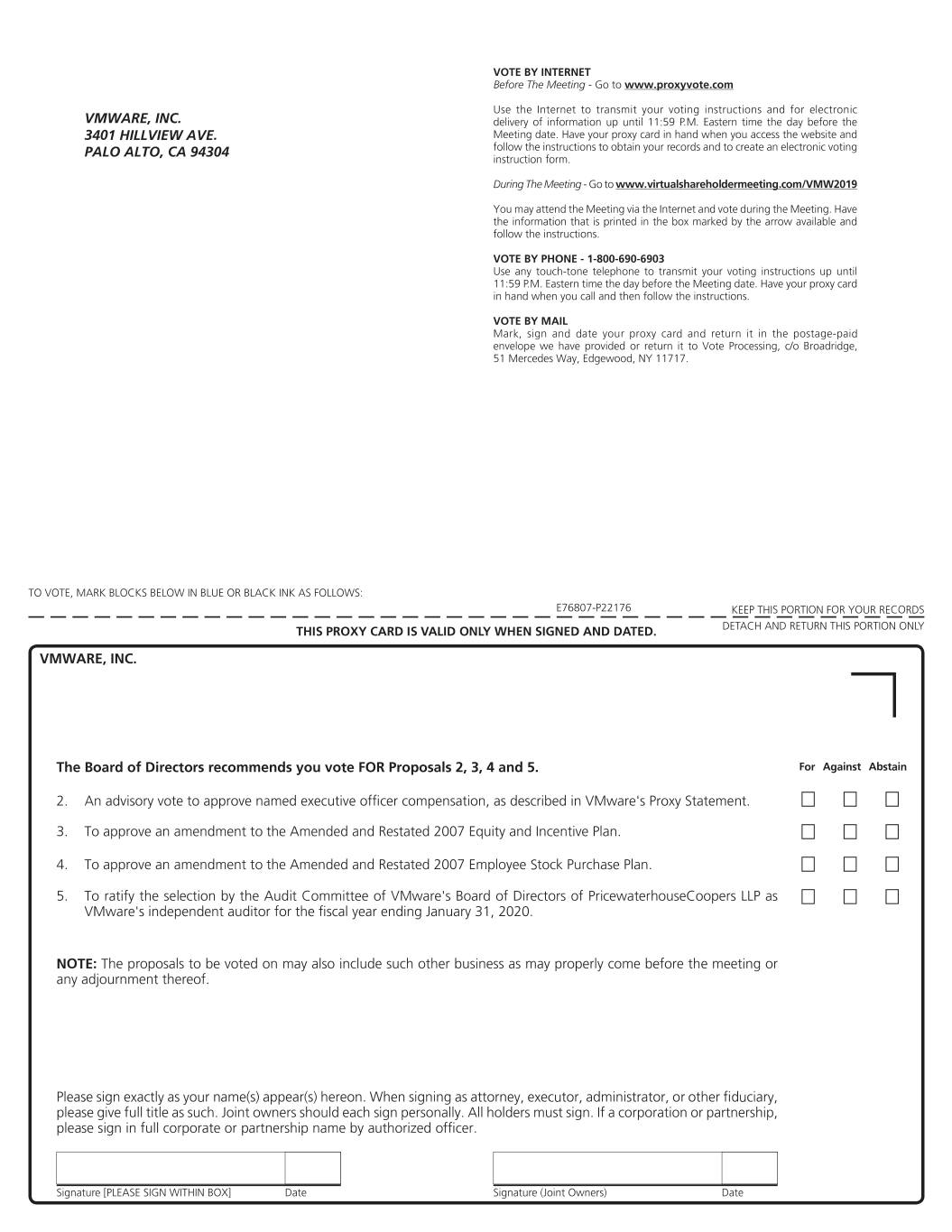Appendix B
VMWARE, INC. 3401 HILLVIEW AVE. PALO ALTO, CA 94304 VOTE BY INTERNET Before
AMENDED AND RESTATED 2007 EQUITY AND INCENTIVE PLAN
1.PURPOSE; TYPES OF AWARDS; CONSTRUCTION.
The Meeting—Gopurpose of the VMware, Inc. Amended and Restated 2007 Equity and Incentive Plan is to www.proxyvote.com Useattract, motivate and retain employees and independent contractors of the InternetCompany and any Subsidiary and Affiliate and non-employee directors of the Company, any Subsidiary or any Affiliate. The Plan is also designed to transmit your voting instructions and for electronic deliveryencourage stock ownership by such persons, thereby aligning their interest with those of information up until 11:59 P.M. Eastern time the day before the Meeting date. Have your proxy card in hand when you access the website and follow the instructions to obtain your recordsCompany’s shareholders and to create an electronic voting instruction form. During The Meeting—Gopermit the payment of compensation that qualifies as performance-based compensation under Section 162(m) of the Code. Pursuant to www.virtualshareholdermeeting.com/VMW2018 Youthe provisions hereof, there may attendbe granted Options (including “incentive stock options” and “non-qualified stock options”), and Other Stock-Based Awards, including but not limited to Restricted Stock, Restricted Stock Units, Stock Appreciation Rights (payable in shares) and Other Cash-Based Awards.
2.DEFINITIONS. For purposes of the Meeting viaPlan, the Internet and vote duringfollowing terms are defined as set forth below:
(a)“Adoption Date” means June 5, 2017, the Meeting. Have the information that is printed in the box markeddate approved by the arrow available and followBoard as the instructions. VOTE BYadoption date of the Plan, including the extension of its term as set forth in Section 7(f) below.
PHONE—1-800-690-6903(b) Use“Affiliate” means an affiliate of the Company, as defined in Rule 12b-2 promulgated under Section 12 of the Exchange Act.
(c)“Award” means individually or collectively, a grant under the Plan of Options, Restricted Stock, Restricted Stock Units, Stock Appreciation Rights or Other Stock-Based Awards or Other Cash-Based Awards.
(d)“Award Terms” means any touch-tone telephonewritten agreement, contract, notice or other instrument or document evidencing an Award.
(e)“Beneficial Owner” has the meaning ascribed to transmit your voting instructions up until 11:59 P.M. Eastern timesuch term in Rule 13d-3 of the day beforeExchange Act.
(f)“Board” means the Meeting date. Have your proxy card in hand when you call and then follow the instructions. VOTE BY MAIL Mark, sign and date your proxy card and return it in the postage-paid envelope we have provided or return it to Vote Processing, c/o Broadridge, 51 Mercedes Way, Edgewood, NY 11717. TO VOTE, MARK BLOCKS BELOW IN BLUE OR BLACK INK AS FOLLOWS: E48164-P03749 KEEP THIS PORTION FOR YOUR RECORDS THIS PROXY CARD IS VALID ONLY WHEN SIGNED AND DATED. DETACH AND RETURN THIS PORTION ONLY VMWARE, INC. The Board of Directors recommends you vote FOR Proposals 2 and 3. 2. An advisory vote to approve named executive officer compensation, as described in VMware’s Proxy Statement. 3. To ratify the selection by the Audit Committee of VMware’s Board of Directors of PricewaterhouseCoopers LLPthe Company.
(g)“Cause,” unless otherwise defined in the Award Terms for a particular Award or in any employment or other agreement between the Grantee and the Company, any Subsidiary or any Affiliate, means:
(i)willful neglect, failure or refusal by the Grantee to perform his or her employment duties (except resulting from the Grantee’s incapacity due to illness) as VMware’s independent auditorreasonably directed by his or her employer;
(ii)willful misconduct by the Grantee in the performance of his or her employment duties;
(iii)the Grantee’s indictment for a felony (other than a traffic related offense) or a misdemeanor involving moral turpitude; or
(iv)the fiscal year ending February 1, 2019. NOTE: The proposalsGrantee’s commission of an act involving personal dishonesty that results in financial, reputational, or other harm to be voted on may also includethe Company, any Affiliate or any Subsidiary, including, but not limited to, an act constituting misappropriation or embezzlement of property.
(h) “Code” means the Internal Revenue Code of 1986, as amended from time to time.
(i)“Committee” means the Compensation and Corporate Governance Committee of the Board or such other business as may properly come beforeBoard committee delegated authority by the meetingBoard to administer and oversee this Plan. Unless other determined by the Board, the Committee will be comprised solely of directors who are (a) “non-employee directors” under Rule 16b-3 of the Exchange Act, (b) “outside directors” under Section 162(m) of the Code and (c) who otherwise meet the definition of “independent directors” pursuant to the applicable requirements of any national stock exchange upon which the Stock is listed. Any director appointed to the Committee who does not meet the foregoing requirements should recuse himself or any adjournment thereof. For Against Abstain Please sign exactly as your name(s) appear(s) hereon. When signing as attorney, executor, administrator, or other fiduciary, please give full title as such. Joint owners should each sign personally. All holders must sign. If a corporation or partnership, please sign in full corporate or partnership name by authorized officer. Signature [PLEASE SIGN WITHIN BOX] Date Signature (Joint Owners) Date
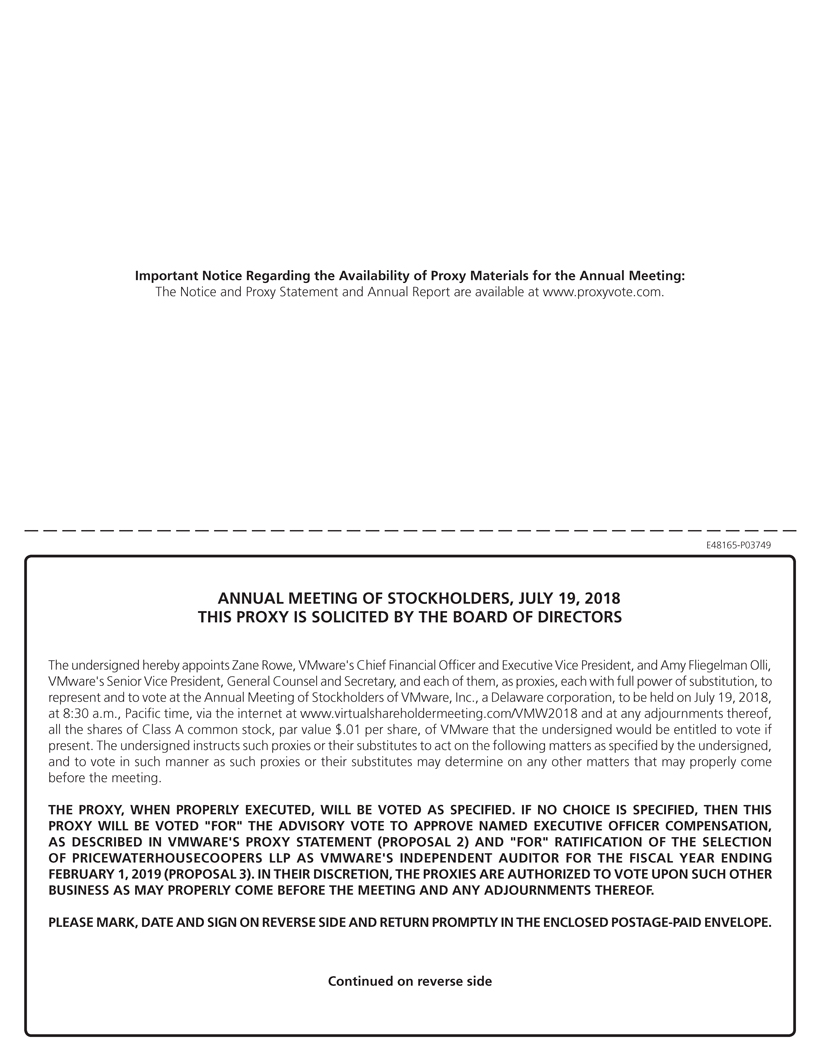
Important Notice Regardingherself from all determinations pertaining to Rule 16b-3 of the AvailabilityExchange Act and Section 162(m) of Proxy Materials for the Annual Meeting: The Notice and Proxy Statement and Annual Report are available at www.proxyvote.com. E48165-P03749 ANNUAL MEETING OF STOCKHOLDERS, JULY 19, 2018 THIS PROXY IS SOLICITED BY THE BOARD OF DIRECTORS The undersigned hereby appoints Zane Rowe, VMware’s Chief Financial Officer and Executive Vice President, and Amy Fliegelman Olli, VMware’s Senior Vice President, General Counsel and Secretary, and each of them, as proxies, each with full power of substitution, to represent and to vote at the Annual Meeting of Stockholders ofCode.
(j)“Company” means VMware, Inc., a corporation organized under the laws of the State of Delaware, corporation,or any successor corporation.
(k)“Covered Employee” has the meaning set forth in Section 162(m)(3) of the Code.
(l)“Exchange Act” means the Securities Exchange Act of 1934, as amended from time to time, and as now or hereafter construed, interpreted and applied by regulations, rulings and cases.
(m)“Fair Market Value” means the closing sales price per share of Stock on the principal securities exchange on which the Stock is traded (i) on the date of grant or (ii) on such other date on which the fair market value of Stock is required to be heldcalculated pursuant to the terms of an Award, provided that if there is no such sale on July 19, 2018, at 8:30 a.m.the relevant date, then on the last previous day on which a sale was reported; if the Stock is not listed for trading on a national securities exchange, the fair market value of Stock will be determined in good faith by the Committee.
(n)“Grantee” means a person who, as an employee, independent contractor or non-employee director of the Company, a Subsidiary or an Affiliate, has been granted an Award under the Plan.
(o) “ISO” means any Option designated as and intended to be and which qualifies as an incentive stock option within the meaning of Section 422 of the Code.
(p)“NQSO” means any Option that is designated as a nonqualified stock option or which does not qualify as an ISO.
(q)“Option” means a right, granted to a Grantee under Section 6(b)(i), Pacific time, viato purchase shares of Stock. An Option may be either an ISO or an NQSO.
(r)“Other Cash-Based Award” means a cash-based Award granted to a Grantee under Section 6(b)(iv) hereof, including cash awarded as a bonus or upon the internet at www.virtualshareholdermeeting.com/VMW2018attainment of Performance Goals or otherwise as permitted under the Plan.
(s)“Other Stock-Based Award” means an Award granted to a Grantee pursuant to Section 6(b)(iv) hereof, that may be denominated or payable in, valued in whole or in part by reference to, or otherwise based on, or related to, Stock, each of which may be subject to the attainment of Performance Goals or a period of continued employment or other terms and atconditions as permitted under the Plan.
(t)“Parent” means Dell Technologies Inc., a Delaware corporation.
(u)“Performance Goals” means an objective formula or standard determined by the Committee with respect to each performance period utilizing one or more of the following factors and any adjournmentsobjectively verifiable adjustment(s) thereto permitted and pre-established by the Committee: (i) (A) earnings including operating income, (B) earnings before or after (1) taxes, (2) interest, (3) depreciation, (4) amortization, or (5) special items or book value per share (which may exclude nonrecurring items), or (C) growth in earnings before interest, tax, depreciation or amortization; (ii) pre-tax income or after-tax income; (iii) earnings per common share (basic or diluted); (iv) operating profit; (v) revenue, revenue growth or rate of revenue growth; (vi) return on assets (gross or net), return on investment, return on capital, return on invested capital or return on equity; (vii) returns on sales or revenues; (viii) operating expenses; (ix) stock price appreciation; (x) cash flow, free cash flow, cash flow from operations, cash flow return on investment (discounted or otherwise), net cash provided by operations, or cash flow in excess of cost of capital; (xi) implementation or completion of critical projects or processes; (xii) economic value created; (xiii) cumulative earnings per share growth; (xiv) operating margin or profit margin; (xv) common stock price or total stockholder return; (xvi) cost targets, reductions, savings, productivity or efficiencies; (xvii) strategic business criteria, consisting of one or more objectives based on meeting specified market penetration, geographic business expansion, customer satisfaction, employee satisfaction, human resources management, supervision of litigation, information technology, goals relating to acquisitions, divestitures, joint ventures or similar transactions, research or development collaborations or budget comparisons; (xviii) personal professional objectives, including any of the foregoing performance goals, the implementation of policies and plans, the negotiation of transactions and the development of long term business goals; and (xix) any combination of, subset or component of, or a specified increase in, any of the foregoing. Where applicable, the Performance Goals may be expressed in terms of attaining a specified level of the particular criteria or the attainment of a percentage increase or decrease in the particular criteria, and may be applied to one or more of the Company, a Subsidiary or Affiliate, or a division or strategic business unit of the Company, or may be applied to the performance of the Company relative to a market index, a group of other companies or a combination thereof, all as determined by the Committee. The Performance Goals may include a
threshold level of performance below which no payment will be made (or no vesting will occur), levels of performance at which specified payments will be made (or specified vesting will occur), and a maximum level of performance above which no additional payment will be made (or at which full vesting will occur). Objectively verifiable adjustment(s) to Performance Goals can include but are not limited to adjustment(s) to reflect: (1) the impact of specific corporate transactions; (2) accounting or tax law changes; (3) asset write-downs; (4) significant litigation or claim adjustment; (5) foreign exchange gains and losses; (6) disposal of a segment of a business; (7) discontinued operations; (8) refinancing or repurchase of bank loans or debt securities; or (9) unbudgeted capital expenditures. Each of the foregoing Performance Goals will be subject to certification by the Committee; provided that, to the extent an Award is intended to satisfy the performance-based compensation exception to the limits of Section 162(m) of the Code and then to the extent consistent with such exception, the Committee has the authority to make equitable adjustments to the Performance Goals in recognition of unusual or non-recurring events affecting the Company or any Subsidiary or Affiliate or the financial statements of the Company or any Subsidiary or Affiliate, in response to changes in applicable laws or regulations or related to the disposal of a segment of a business or related to a change in generally accepted accounting principles.
(v) “Plan” means this Amended and Restated VMware, Inc. 2007 Equity and Incentive Plan, as amended from time to time.
(w)“Restricted Stock” means an Award of shares of Stock to a Grantee under Section 6(b)(ii) that is subject to certain restrictions and to a risk of forfeiture.
(x)“Restricted Stock Unit” means a right granted to a Grantee under Section 6(b)(iii) of the Plan to receive shares of Stock subject to certain restrictions and to a risk of forfeiture.
(y)“Rule 16b-3” means Rule 16b-3, as from time to time in effect promulgated by the Securities and Exchange Commission under Section 16 of the Exchange Act, including any successor to such Rule.
(z)“Stock” means shares of Class A common stock, par value $.01$0.01 per share, of VMwarethe Company.
(aa)“Stock Appreciation Right” means an Award that entitles a Grantee upon exercise to the excess of the Fair Market Value of the Stock underlying the Award over the base price established in respect of such Stock.
(ab)“Subsidiary” means any entity in an unbroken chain of entities beginning with the Company if, at the time of granting of an Award, each of the entities (other than the last entity in the unbroken chain) owns stock possessing 50% or more of the total combined voting power of all classes of stock in one of the other entities in the chain.
3.ADMINISTRATION.
(a)The Plan will be administered by the Committee or, at the discretion of the Board, the Board. In the event the Board is the administrator of the Plan, references herein to the Committee will be deemed to include the Board. The Board may from time to time appoint a member or members of the Committee in substitution for or in addition to the member or members then in office and may fill vacancies on the Committee however caused. Subject to applicable law, the Board or the Committee may delegate to a sub-committee or individual the ability to grant Awards to employees who are not subject to potential liability under Section 16(b) of the Exchange Act with respect to transactions involving equity securities of the Company at the time any such delegated authority is exercised.
(b)The decision of the Committee as to all questions of interpretation and application of the Plan will be final, binding and conclusive on all persons. The Committee has the authority in its discretion, subject to and not inconsistent with the express provisions of the Plan, to administer the Plan and to exercise all the power and authority either specifically granted to it under the Plan or necessary or advisable in the administration of the Plan, including without limitation, the authority to grant Awards; determine the persons to whom and the time or times at which Awards will be granted; determine the type and number of Awards to be granted, the number of shares of Stock to which an Award may relate and the terms, conditions, restrictions and Performance Goals relating to any Award; determine Performance Goals no later than such time as is required to ensure that an underlying Award which is intended to comply with the requirements of Section 162(m) of the Code so complies; determine whether, to what extent, and under what circumstances an Award may be settled, canceled, forfeited, accelerated, exchanged, or surrendered (including upon a “change in control” or similar transaction); to make adjustments in the terms and conditions (including Performance Goals) applicable to Awards; construe and interpret the Plan and any Award; prescribe, amend and rescind rules and regulations relating to the Plan; to determine the terms and provisions of the Award Terms (which need not be identical for each Grantee); and make all other determinations deemed necessary or advisable for the administration of the Plan. The Committee may correct any defect or supply any omission or reconcile any
inconsistency in the Plan or in any Award Terms granted hereunder in the manner and to the extent it deems expedient to carry the Plan into effect and will be the sole and final judge of such expediency. No Committee member will be liable for any action or determination made with respect to the Plan or any Award.
4.ELIGIBILITY.
(a)Awards may be granted to officers, employees, independent contractors and non-employee directors of the Company or of any of the Subsidiaries and Affiliates; provided, that (i) ISOs may be granted only to employees (including officers and directors who are also employees) of the Company or any of its “related corporations” (as defined in the applicable regulations promulgated under the Code) and (ii) Awards may be granted only to eligible persons who are not employed by the Company or a Subsidiary if such persons perform substantial services for the Company or a Subsidiary.
(b)No ISO may be granted to any employee of the Company or any of its Subsidiaries if such employee owns, immediately prior to the grant of the ISO, stock representing more than 10% of the voting power or more than 10% of the value of all classes of stock of the Company or Parent or a Subsidiary, unless the purchase price for the stock under such ISO is at least 110% of its Fair Market Value at the time such ISO is granted and the ISO, by its terms, will not be exercisable more than five years from the date it is granted. In determining the stock ownership under this paragraph, the provisions of Section 424(d) of the Code will control.
(c)No Award, except for Restricted Stock, may be granted to any employee or independent contractor who is subject to Section 409A of the Code if such person is an employee or independent contractor of an Affiliate that is not a Subsidiary, unless such Award conforms to the requirements of Section 409A.
5.STOCK SUBJECT TO THE PLAN.
(a)The maximum number of shares of Stock reserved for the grant or settlement of Awards under the Plan (the “Share Limit”) is 145,167,881, subject to adjustment as provided herein, not including shares of stock added to the Share Limit pursuant to Section 5(c).
(b)Shares issued pursuant to Awards under the Plan may, in whole or in part, be authorized but unissued shares or shares that have been or may be reacquired by the Company in the open market, in private transactions or otherwise. If any shares subject to an Award (other than Awards substituted or assumed pursuant to Section 5(c) herein) are forfeited, canceled, exchanged or surrendered or if an Award otherwise terminates or expires without a distribution of shares to the Grantee, the shares of stock with respect to such Award will, to the extent of any such forfeiture, cancellation, exchange, surrender, termination or expiration, again be available for Awards under the Plan.
(c)The Company may substitute or assume equity awards of acquired entities in connection with mergers, reorganizations, separations, or other transactions to which Section 424(a) of the Code applies. The number of shares of Stock reserved pursuant to Section 5 will be increased by the corresponding number of equity awards assumed and, in the case of a substitution, by the net increase in the number of shares of Stock subject to equity awards before and after the substitution.
(d)Subject to the Share Limit and Section 5(g), the aggregate maximum number of shares of Stock that may be issued pursuant to the exercise of ISOs will be 145,167,881 shares of Stock.
(e)Subject to the Share Limit and Section 5(g), the aggregate number of shares of Stock that may be issued pursuant to Awards granted during any fiscal year to any single individual may not exceed 3,611,400 shares of Stock.
(f)The maximum value of Awards granted during a single fiscal year under this Plan or under any other equity plan maintained by the Company, taken together with any cash fees paid during such fiscal year for services on the Board, will not exceed $1,000,000 in total value for any non-employee director, except that such limit will be $1,250,000 for any non-employee director serving as the lead director of the Board or chair of the Board. Such applicable limit will include the value of any stock awards that are received in lieu of all or a portion of any annual committee cash retainers or other similar cash based payments.
(g)Except as provided in an Award Term or as otherwise provided in the Plan, in the event of any extraordinary dividend or other extraordinary distribution (whether in the form of cash, Stock, or other property), recapitalization, stock split, reverse split, reorganization, merger, consolidation, spin-off, recapitalization, combination, repurchase, or share exchange, or other similar corporate transaction or event, the Committee will make such equitable changes
or adjustments as it deems necessary or appropriate to any or all of (i) the number and kind of shares of Stock or other property (including cash) that may thereafter be issued in connection with Awards (including, but not limited to changes or adjustments to the limits specified in Sections 5(d) and (e)) or the total number of Awards issuable under the Plan, (ii) the number and kind of shares of Stock or other property issued or issuable in respect of outstanding Awards, (iii) the exercise price, grant price or purchase price relating to any Award, (iv) the Performance Goals, and (v) the individual limitations applicable to Awards; provided that, with respect to ISOs, any adjustment will be made in accordance with the provisions of Section 424(h) of the Code and any regulations or guidance promulgated thereunder, and provided further that no such adjustment will cause any Award hereunder which is or becomes subject to Section 409A of the Code to fail to comply with the requirements of such section.
6.SPECIFIC TERMS OF AWARDS.
(a)General. Subject to the terms of the Plan and any applicable Award Terms, (i) the term of each Award will be for such period as may be determined by the Committee, and (ii) payments to be made by the Company or a Subsidiary or Affiliate upon the grant, maturation, or exercise of an Award may be made in such forms as the Committee determines at the date of grant or thereafter, including, without limitation, cash, Stock or other property, and may be made in a single payment or transfer, in installments, or, subject to the requirements of Section 409A of the Code on a deferred basis.
(b)Awards. The Committee is authorized to grant to Grantees the following Awards, as deemed by the Committee to be consistent with the purposes of the Plan. The Committee will determine the terms and conditions of such Awards, consistent with the terms of the Plan. Options and Stock Appreciation Rights (“SARs”) are subject to a minimum one-year vesting period following grant, with the exception that up to 5% of the available shares of Stock reserved for grant may be subject to such Awards without such minimum vesting period. Subject to compliance with the requirements of Section 409A of the Code, an Award may provide the Grantee with the right to receive dividend or dividend equivalent payments with respect to Stock actually or notionally subject to the Award, which payments will be credited to an account for the Grantee, and may be settled in cash or Stock, as determined by the Committee. Any such dividend or dividend equivalents will be settled in cash or Stock to the Grantee only if, when and to the extent the related Award vests. The value of dividend or dividend equivalent payments payable with respect to any Award that does not vest will be forfeited.
(i)Options. The Committee is authorized to grant Options to Grantees on the following terms and conditions:
(A)The Award Terms evidencing the grant of an Option under the Plan will designate the Option as an ISO or an NQSO.
(B)The exercise price per share of Stock purchasable under an Option will be determined by the Committee, but in no event may the exercise price of an Option per share of Stock be less than the Fair Market Value of a share of Stock as of the date of grant of such Option. The purchase price of Stock as to which an Option is exercised must be paid in full at the time of exercise; payment may be made in cash, which may be paid by check, or other instrument acceptable to the Company, or, with the consent of the Committee, in shares of Stock, valued at the Fair Market Value on the date of exercise (including shares of Stock that otherwise would be distributed to the Grantee upon exercise of the Option), or if there were no sales on such date, on the next preceding day on which there were sales or (if permitted by the Committee and subject to such terms and conditions as it may determine) by surrender of outstanding Awards under the Plan, or the Committee may permit such payment of exercise price by any other method it deems satisfactory in its discretion. In addition, subject to applicable law and pursuant to procedures approved by the Committee, payment of the exercise price may be made pursuant to a broker-assisted cashless exercise procedure. Any amount necessary to satisfy applicable federal, state or local tax withholding requirements must be paid promptly upon notification of the amount due. The Committee may permit the amount of tax withholding to be paid in shares of Stock previously owned by the employee, or a portion of the shares of Stock that otherwise would be distributed to such employee upon exercise of the Option, or a combination of shares of such Stock and other property, except that the undersigned wouldamount of tax withholding to be satisfied by withholding shares of Stock and other property will be limited to the extent necessary to avoid adverse accounting consequences, including but not limited to the Award being classified as a liability award.
(C)Options will be exercisable over the exercise period (which may not exceed ten years from the date of grant), at such times and upon such conditions as the Committee may determine, as reflected in the Award Terms; provided that, the Committee has the authority to accelerate the exercisability of any outstanding Option at such time and under such circumstances as it, in its sole discretion, deems appropriate.
(D)Upon the termination of a Grantee’s employment or service with the Company and its Subsidiaries or Affiliates, the Options granted to such Grantee, to the extent that they are exercisable at the time of such termination, will remain exercisable for such period as may be provided in the applicable Award Terms, but in no event following the expiration of their term. The treatment of any Option that is unexercisable as of the date of such termination will be as set forth in the applicable Award Terms.
(E)Options may be subject to such other conditions, as the Committee may prescribe in its discretion or as may be required by applicable law.
(ii)Restricted Stock.
(A)The Committee may grant Awards of Restricted Stock under the Plan, subject to such restrictions, terms and conditions, as the Committee may determine in its sole discretion and as evidenced by the applicable Award Terms (provided that any such Award is subject to the vesting requirements described herein). The vesting of a Restricted Stock Award granted under the Plan may be conditioned upon the completion of a specified period of employment or service with the Company, any Subsidiary or an Affiliate, upon the attainment of specified Performance Goals or upon such other criteria as the Committee may determine in its sole discretion.
(B)The Committee will determine the purchase price, which, to the extent required by law, may not be less than par value of the Stock, to be paid by the Grantee for each share of Restricted Stock or unrestricted Stock or stock units subject to the Award. The Award Terms with respect to such Award will set forth the amount (if any) to be paid by the Grantee with respect to such Award and when and under what circumstances such payment is required to be made.
(C)Except as provided in the applicable Award Terms, no shares of Stock underlying a Restricted Stock Award may be assigned, transferred, or otherwise encumbered or disposed of by the Grantee until such shares of Stock have vested in accordance with the terms of such Award.
(D)Upon the termination of a Grantee’s employment or service with the Company and its Subsidiaries or Affiliates, the Restricted Stock granted to such Grantee will be subject to the terms and conditions specified in the applicable Award Terms.
(iii)Restricted Stock Units. The Committee is authorized to grant Restricted Stock Units to Grantees, subject to the following terms and conditions:
(A)At the time of the grant of Restricted Stock Units, the Committee may impose such restrictions or conditions to the vesting of such Awards as it, in its discretion, deems appropriate, including, but not limited to, the achievement of Performance Goals. The Committee has the authority to accelerate the settlement of any outstanding award of Restricted Stock Units at such time and under such circumstances as it, in its sole discretion, deems appropriate, subject compliance with the requirements of Section 409A of the Code.
(B)Unless otherwise provided in the applicable Award Terms or except as otherwise provided in the Plan, upon the vesting of a Restricted Stock Unit there will be delivered to the Grantee, as soon as practicable following the date on which such Award (or any portion thereof) vests, that number of shares of Stock equal to the number of Restricted Stock Units becoming so vested.
(C)Upon the termination of a Grantee’s employment or service with the Company and its Subsidiaries or Affiliates, the Restricted Stock Units granted to such Grantee will be subject to the terms and conditions specified in the applicable Award Terms.
(iv)Other Stock-Based or Cash-Based Awards.
(A)The Committee is authorized to grant Awards to Grantees in the form of Other Stock-Based Awards or Other Cash-Based Awards, as deemed by the Committee to be consistent with the purposes of the Plan. The Committee will determine the terms and conditions of such Awards, consistent with the terms of the Plan, at the date of grant or thereafter, including the Performance Goals and performance periods. Stock or other securities or property delivered pursuant to an Award in the nature of a purchase right granted under Section 6(iv) may be purchased for such consideration, paid for at such times, by such methods, and in such forms, including, without limitation, Stock, other Awards, notes or other property, as the Committee will determine, subject to any required corporate action.
(B)With respect to a Covered Employee, the maximum value of the aggregate payment that any Grantee may receive with respect to Other Cash-Based Awards pursuant to this Section 6(b)(iv) in respect of any annual performance period is $5,000,000and for any other performance period in excess of one year, such amount multiplied by a fraction, the numerator of which is the number of months in the performance period and the denominator of which is twelve. No payment may be made to a Covered Employee prior to the certification by the Committee that the Performance Goals have been attained. The Committee may establish such other rules applicable to the Other Stock- or Cash-Based Awards to the extent not inconsistent with Section 162(m) of the Code.
(C)Payments earned in respect of any Cash-Based Award may be decreased or, with respect to any Grantee who is not a Covered Employee, increased in the sole discretion of the Committee based on such factors as it deems appropriate.
7.GENERAL PROVISIONS.
(a)Nontransferability, Deferrals and Settlements. Unless otherwise determined by the Committee or provided in an Award Term or set forth below, but in accordance with the Code and any applicable laws, Awards will not be transferable by a Grantee except by will or the laws of descent and distribution and will be exercisable during the lifetime of a Grantee only by such Grantee or his guardian or legal representative. Any attempted assignment or transfer of an Award will be null and void and without effect, except as herein provided, including without limitation any purported assignment, whether voluntary or by operation of law, pledge, hypothecation or other disposition, attachment, divorce, trustee process or similar process, whether legal or equitable, upon such Award. The Committee may permit Grantees to elect to defer the issuance of shares of Stock or the settlement of Awards in cash under such rules and procedures as established under the Plan to the extent that such deferral complies with Section 409A of the Code and any regulations or guidance promulgated thereunder.
(b)Leave of Absence; Reduction in Service Level. The Committee may determine, in its discretion (i) whether, and the extent to which, an Award will vest during a leave of absence, (ii) whether, and the extent to which, a reduction in service level (for example, from full-time to part-time employment), will cause a reduction, or other change, in an Award, and (iii) whether a leave of absence or reduction in service will be deemed a termination of employment or service for the purpose of the Plan and the Award Terms. The Committee will also determine all other matters relating to whether the employment or service of a recipient of an Award is continuous for purposes of the Plan and the Award Terms.
(c)No Right to Continued Employment, etc. Nothing in the Plan or in any Award granted or any Award Terms, promissory note or other agreement entered into pursuant hereto confers upon any Grantee the right to continue in the employ or service of the Company, any Subsidiary or any Affiliate or to be entitled to voteany remuneration or benefits not set forth in the Plan or the applicable Award Terms or to interfere with or limit in any way the right of the Company or any such Subsidiary or Affiliate to terminate such Grantee’s employment or service.
(d)Clawback/Recoupment
(i)All Awards granted under the Plan will be subject to recoupment in accordance with any clawback policy that the Company determines to adopt pursuant to the listing standards of any national securities exchange or association on which the Company’s securities are listed or as is otherwise required by the Dodd-Frank Wall Street Reform and Consumer Protection Act or other applicable law. In addition, the Committee may impose additional clawback, recovery or recoupment provisions in an Award agreement as the Committee determines necessary or appropriate, including but not limited to a reacquisition right in respect of previously acquired shares of Stock or other cash or property upon the occurrence of Cause as determined by the Committee.
(ii)In the event of a restatement of incorrect financial results, the Committee will review all Awards held by executive officers (within the meaning of Rule 3b-7 of the Exchange Act) of the Company that (i) were earned based on performance or were vesting during the course of the financial period subject to such restatement or (ii) were granted during or within one year following such financial period. If any Award would have been lower or would not have vested, been earned or been granted based on such restated financial results, the Committee will, if present.it determines appropriate in its sole discretion and to the extent permitted by governing law, (a) cancel such Award, in whole or in part, whether or not vested, earned or payable or (b) require the Grantee to repay to the Company an amount equal to all or any portion of the value of any gains from the grant, vesting or payment of the Award that would not have been realized had the restatement not occurred.
(iii)If a Grantee’s employment or service is terminated for Cause, all unvested (and, to the extent applicable, unexercised) portions of Awards will terminate and be forfeited immediately without consideration. In addition, the Committee may in its sole discretion and to the extent permitted by applicable law cause the cancellation of all or a portion of any outstanding vested Awards held by such Grantee or payable to such Grantee or require such Grantee to reimburse the Company for all or a portion of the gains from the exercise of, settlement or payment of any of the Grantee’s Awards realized after the event giving rise to Cause first occurred.
(e)Taxes. The undersigned instructsCompany, any Subsidiary and any Affiliate is authorized to withhold from any Award granted, any payment relating to an Award under the Plan, including from a distribution of Stock, or any other payment to a Grantee, amounts of withholding and other taxes due in connection with any transaction involving an Award, and to take such proxiesother action as the Committee may deem advisable to enable the Company and Grantees to satisfy obligations for the payment of withholding taxes and other tax obligations relating to any Award. This authority includes authority to withhold or their substitutesreceive Stock or other property and to actmake cash payments in respect thereof in satisfaction of a Grantee’s tax obligations; provided, however, that the amount of tax withholding to be satisfied by withholding Stock or other property will be limited to the extent necessary to avoid adverse accounting consequences, including but not limited to the Award being classified as a liability award.
(f)Stockholder Approval; Amendment and Termination. The Board may amend, alter or discontinue the Plan and outstanding Awards thereunder, but no amendment, alteration, or discontinuation may be made that would impair the rights of a Grantee under any Award theretofore granted without such Grantee’s consent, or that without the approval of the stockholders (as described below) would, except in the case of an adjustment as provided in Section 5, increase the total number of shares of Stock reserved for the purpose of the Plan. In addition, stockholder approval will be required with respect to any amendment with respect to which shareholder approval is required under the Code, the rules of any stock exchange on which Stock is then listed or any other applicable law. Unless earlier terminated by the Board pursuant to the provisions of the Plan, the Plan will terminate on the tenth anniversary of the Adoption Date.No Awards may be granted under the Plan after such termination date.
(g)No Rights to Awards; No Stockholder Rights. No Grantee haves any claim to be granted any Award under the Plan, and there is no obligation for uniformity of treatment of Grantees. No Grantee has any right to payment or settlement under any Award unless and until the Committee or its designee determines that payment or settlement is to be made. Except as provided specifically herein, a Grantee or a transferee of an Award has no rights as a stockholder with respect to any shares covered by the Award until the date of the issuance of such shares.
(h)Unfunded Status of Awards. The Plan is intended to constitute an “unfunded” plan for incentive and deferred compensation. With respect to any payments not yet made to a Grantee pursuant to an Award, nothing contained in the Plan or any Award will give any such Grantee any rights that are greater than those of a general creditor of the Company.
(i)No Fractional Shares. No fractional shares of Stock will be issued or delivered pursuant to the Plan or any Award. The Committee will determine whether cash, other Awards, or other property will be issued or paid in lieu of such fractional shares or whether such fractional shares or any rights thereto will be forfeited or otherwise eliminated.
(j)Regulations and Other Approvals.
(i)The obligation of the Company to sell or deliver Stock or pay cash with respect to any Award granted under the Plan is subject to all applicable laws, rules and regulations, including all applicable federal and state securities laws, and the obtaining of all such approvals by governmental agencies as may be deemed necessary or appropriate by the Committee.
(ii)Each Award is subject to the requirement that, if at any time the Committee determines, in its absolute discretion, that the listing, registration or qualification of Stock issuable pursuant to the Plan is required by any securities exchange or under any state or federal law, or the consent or approval of any governmental regulatory body is necessary or desirable as a condition of, or in connection with, the grant of an Award or the issuance of Stock, no such Award may be granted or payment made or Stock issued, in whole or in part, unless listing, registration, qualification, consent or approval has been effected or obtained free of any conditions not acceptable to the Committee.
(iii)In the event that the disposition of Stock acquired pursuant to the Plan is not covered by a then current registration statement under the Securities Act of 1933, as amended (the “Securities Act”), and is not otherwise exempt from such registration, such Stock will be restricted against transfer to the extent required by the Securities Act or regulations thereunder, and the Committee may require a Grantee receiving Stock pursuant to the Plan, as a condition precedent
to receipt of such Stock, to represent to the Company in writing that the Stock acquired by such Grantee is acquired for investment only and not with a view to distribution.
(iv)Section 409A. This Plan is intended to comply and will be administered in a manner that is intended to comply with Section 409A of the Code and will be construed and interpreted in accordance with such intent. To the extent that an Award, issuance or payment is subject to Section 409A of the Code, it will be awarded or issued or paid in a manner that will comply with Section 409A of the Code, including proposed, temporary or final regulations or any other guidance issued by the Secretary of the Treasury and the Internal Revenue Service with respect thereto. Any provision of this Plan that would cause an Award, issuance or payment to fail to satisfy Section 409A of the Code will have no force and effect until amended to comply with Section 409A of the Code (which amendment may be retroactive to the extent permitted by applicable law). Notwithstanding anything to the contrary in this Plan (and unless the Award Terms specifically provides otherwise), if the shares of Stock are publicly traded and a Grantee is a “specified employee” for purposes of Section 409A of the Code and holds an Award that provides for “deferred compensation” under Section 409A of the Code, no distribution or payment of any amount shall be made upon a “separation from service” before a date that is six months following mattersthe date of such Grantee’s “separation from service” (as defined in Section 409A of the Code without regard to alternative definitions thereunder) except that in case of the Grantee’s death, such distribution or payment will be made as soon as practicable following the Grantee’s death or as otherwise set forth in an agreement with the Grantee.
(k)Governing Law. The Plan and all determinations made and actions taken pursuant hereto is governed by the laws of the State of Delaware without giving effect to the conflict of laws principles thereof. Notwithstanding anything to the contrary herein, the Committee, in order to conform with provisions of local laws and regulations in foreign countries in which the Company or its Subsidiaries operate, has sole discretion to (i) modify the terms and conditions of Awards made to Grantees employed outside the United States, (ii) establish sub-plans with modified exercise procedures and such other modifications as may be necessary or advisable under the circumstances presented by local laws and regulations, and (iii) take any action which it deems advisable to obtain, comply with or otherwise reflect any necessary governmental regulatory procedures, exemptions or approvals with respect to the Plan or any sub-plan established hereunder.
(l)Merger or Consolidation. If the Company is the surviving corporation in any merger or consolidation (other than a merger or consolidation in which the Company survives but in which a majority of its outstanding shares are converted into securities of another corporation or are exchanged for other consideration), any Award granted hereunder will pertain and apply to the securities which a holder of the number of shares of stock of the Company then subject to the Award is entitled to receive. In the event of a (i) dissolution or liquidation of the Company, (ii) sale or transfer of all or substantially all of the Company’s assets or (iii) merger or consolidation in which the Company is not the surviving corporation or in which a majority of its outstanding shares are converted into securities of another corporation or are exchanged for other consideration, the Company must, contingent upon consummation of such transaction, either (a) arrange for any corporation succeeding to the business and assets of the Company to (x) assume each outstanding Award, or (y) issue to the Grantees replacement Awards (which, in the case of Incentive Stock Options, satisfy, in the determination of the Committee, the requirements of Section 424 of the Code), for such corporation’s stock that will preserve the value, liquidity and material terms and conditions of the outstanding Awards; or (b) make the outstanding Awards fully exercisable or cause all of the applicable restrictions to which outstanding Stock Awards are subject to lapse, in each case, on a basis that gives the holder of the Award a reasonable opportunity, as determined by the Committee, following the exercise of the Award or the issuance of shares of Common Stock, as the case may be, to participate as a stockholder in any such dissolution, liquidation, asset sale or transfer, merger or consolidation, and the Award will terminate immediately following consummation of any such transaction. The existence of the Plan will not prevent any such change or other transaction, and no Participant hereunder has any right except as herein expressly set forth. Notwithstanding the foregoing provisions of this Section 7(m), Awards subject to and intended to satisfy the requirements of Section 409A of the Code will be construed and administered consistent with such intent.
Appendix C
VMWARE, INC.
AMENDED AND RESTATED 2007 EMPLOYEE STOCK PURCHASE PLAN
Section 1. Purpose of Plan
The VMware, Inc. Amended and Restated 2007 Employee Stock Purchase Plan (the “Plan”) is intended to provide a method by which eligible employees of VMware, Inc. (“VMware”) and its subsidiaries (collectively, the “Company”) may use voluntary, systematic payroll deductions or other contributions (as described in Section 5 below) to purchase VMware’s class A common stock, $.01 par value, (“stock”) and thereby acquire an interest in the future of VMware. For purposes of the Plan, a subsidiary is any corporation in which VMware owns, directly or indirectly, stock possessing 50% or more of the total combined voting power of all classes of stock unless the Board of Directors of VMware (the “Board of Directors”) or the Committee (as defined below) determines that employees of a particular subsidiary shall not be eligible.
The Plan is intended qualify as an “employee stock purchase plan” under Section 423 of the Internal Revenue Code of 1986, as amended (the “Code”). Notwithstanding the foregoing, the Board of Directors may establish comparable offerings under the Plan that are not intended to qualify under Code Section 423. Such offerings will be designated as being made under the non-423 component of this Plan.
For purposes of this Plan, if the Board of Directors so determines, the employees of VMware and/or of any designated subsidiary will be deemed to participate in a separate offering under the 423 component of the Plan, even if the dates of the applicable offering period of each such offering are identical, provided that the terms of participation are the same within each separate offering as determined under Code Section 423.
Section 2. Options to Purchase Stock
Under the Plan, no more than 32,300,000 shares of stock are available for purchase (subject to adjustment as provided in Section 16) pursuant to the exercise of options (“options”) granted under the Plan to employees of the Company (“employees”). All of the shares of stock are available for purchase under the Plan may be used for offerings under the 423 component of the Plan. The stock to be delivered upon exercise of options under the Plan may be either shares of VMware’s authorized but unissued stock, or shares of reacquired stock, as the Board of Directors shall determine.
Section 3. Eligible Employees
Except as otherwise provided in Section 20, each employee who has completed three months or more of continuous service in the employ of the Company, or any lesser number of months established by the Committee (if required under local law), shall be eligible to participate in the Plan provided such inclusion is consistent with requirements under Code Section 423 or offered under the non-423 component.Notwithstanding any other provision herein, individuals who are not contemporaneously classified as employees of VMware or an eligible subsidiary for purposes of VMware’s or the applicable eligible subsidiary’s payroll system are not considered to be eligible employees and shall not be eligible to participate in the Plan. In the event any such individuals are reclassified as employees of VMware or an eligible subsidiary for any purpose, including, without limitation, common law or statutory employees, by any action of any third party, including, without limitation, any government agency, or as a result of any private lawsuit, action or administrative proceeding, such individuals shall, notwithstanding such reclassification, remain ineligible for participation. Notwithstanding the foregoing, the exclusive means for individuals who are not contemporaneously classified as employees of VMware or an eligible subsidiary on the applicable payroll system to become eligible to participate in this Plan is through an amendment to this Plan, duly executed by VMware, which specifically renders such individuals eligible to participate herein.
Section 4. Method of Participation
Option periods of any duration up to 27 months in length shall be determined by the Committee. In the event no period is designated by the Committee, the option periods shall have a duration of six months commencing on the first day following termination of the prior period. For example, if an option period ends on July 31, the following option period would be August 1 through January 31 unless the Committee determines otherwise prior to commencement of such following option period. Each person who will be an eligible employee on the first day of any option period may elect to participate in the Plan by executing and delivering, at least one business day prior to such day, a payroll deduction authorization and/or other required enrollment agreement(s)/form(s) in accordance with Section 5. Such employee shall thereby become a participant
(“participant”) on the first day of such option period and shall remain a participant until his or her participation is terminated as provided in the Plan. VMware may permit participants to elect or indicate whether an enrollment election, once made, will apply to subsequent option periods without being required to submit a new enrollment form. If an employee makes an enrollment election that does not apply to subsequent option periods, the employee will be deemed to have terminated his or her participation with respect to subsequent option periods unless and until the employee submits a new enrollment form in accordance with the Plan.
Section 5. Contributions
A participant may elect to make contributions under the Plan at a rate of not less than 2% nor more than 15% from the participant’s compensation (subject to a maximum of $7,500 per six-month option period and pro-rated for longer or shorter periods, at the Committee’s discretion), by means of substantially equal payroll deductions over the option period; provided, however, where applicable local laws prohibit payroll deductions for the purpose of participation in the Plan, the Committee may permit all participants in a specified separate offering under the 423 component or an offering under the non-423 component of the Plan to contribute amounts to the Plan through payment by cash, check or other means set forth in the enrollment form. Any amount remaining in a participant’s contribution account at the end of an option period representing a fractional share that is rolled over to the contribution account for the next option period pursuant to Section 8 below (a “rollover”) may be used to purchase additional stock; provided that the maximum dollar amount per option period shall be reduced by the amount of any rollover. For purposes of the Plan, “compensation” shall mean all cash compensation paid to the participant by the Company unless otherwise specified by the undersigned,Board.
A participant may only elect to change his or her contribution rate by written notice delivered to VMware (or its designated agent) at least one business day prior to the first day of the option period as to which the change is to be effective. Following delivery to VMware (or its designated agent) of any enrollment form or any election to change the withholding rate of a payroll deduction authorization, appropriate payroll deductions or changes thereto shall commence as soon as reasonably practicable. All amounts withheld in accordance with a participant’s payroll deduction authorization or contributed by other permitted means (if any) shall be credited to a contribution account for such participant.
Section 6. Grant of Options
Each person who is a participant on the first day of an option period shall, as of such day, be granted an option for such period. Such option shall be for the number of shares of stock to be determined by dividing (a) the balance in the participant’s contribution account on the last day of the option period by (b) the purchase price per share of the stock determined under Section 7, and eliminating any fractional share from the quotient. In the event that the number of shares then available under the Plan is otherwise insufficient, VMware shall reduce on a substantially proportionate basis the number of shares of stock receivable by each participant upon exercise of his or her option for an option period and shall return the balance in a participant’s contribution account to such participant without interest (unless otherwise required by local law). In no event shall the number of shares of stock that a participant may purchase during any one six-month option period under the Plan exceed 750 shares of stock (subject to adjustment as provided in Section 16), and pro-rated for longer or shorter periods, at the Committee’s discretion.
Section 7. Purchase Price
The purchase price of stock issued pursuant to the exercise of an option shall be 85% of the fair market value of the stock at (a) the time of grant of the option or (b) the time at which the option is deemed exercised, whichever is less. “Fair market value” shall mean the closing sales price per share of the stock on the principal securities exchange on which the stock is traded or, if there is no such sale on the relevant date, then on the last previous day on which a sale was reported; if the stock is not listed for trading on a national securities exchange, the fair market value of the stock shall be determined in good faith by the Board of Directors.
Section 8. Exercise of Options
If an employee is a participant in the Plan on the last business day of an option period, he or she shall be deemed to have exercised the option granted to him or her for that period. Upon such exercise, VMware shall apply the balance of the participant’s contribution account to the purchase of the number of whole shares of stock determined under Section 6, and as soon as practicable thereafter shall issue and deliver certificates for said shares to the participant (or have the shares deposited in a brokerage account for the benefit of the participant). No fractional shares shall be issued hereunder. Any balance accumulated in the participant’s contribution account that is not sufficient to purchase a full share shall be retained in such account for any remaining or subsequent option period, subject to early withdrawal by the participant as provided in Section 10.
Any other monies remaining in the participant’s contribution account under the Plan after the date of exercise shall be returned to the participant or his or her beneficiary (as applicable) in cash without interest (unless otherwise required by local law).
Notwithstanding anything herein to the contrary, VMware shall not be obligated to deliver any shares unless and until, in the opinion of VMware’s counsel, all requirements of applicable federal, state and foreign laws and regulations (including any requirements as to legends) have been complied with, nor, if the outstanding stock is at the time listed on any securities exchange, unless and until the shares to be delivered have been listed (or authorized to be added to the list upon official notice of issuance) upon such exchange, nor unless or until all other legal matters in connection with the issuance and delivery of shares have been approved by VMware’s counsel.
Section 9. Interest
No interest will be payable on contribution accounts, except as may be required by applicable law, as determined by the Committee.
Section 10. Cancellation and Withdrawal
A participant who holds an option under the Plan may cancel all (but not less than all) of his or her option by written notice delivered to the Company, in such form as the Committee may prescribe, provided that VMware (or its designated agent) must receive such notice at least 31 days, or such other number of days determined by the Committee, before the last day of the option period (the “Withdrawal Deadline”). Any participant who delivers such written notice shall be deemed to have canceled his or her option, terminated any applicable payroll deduction authorization with respect to the Plan and terminated his or her participation in the Plan, in each case, as of the date of such written notice. In the event that the date of the Withdrawal Deadline with respect to the applicable option period, shall be a Saturday, Sunday or day on which banks in the State of Delaware are required to close, a participant may cancel his or her option by written notice given on or prior to the last business day immediately preceding such date. Following delivery of any such notice, any balance in the participant’s contribution account will be returned to such participant as soon as reasonably practicable without interest (unless otherwise required by local law). Any participant who has delivered such notice may elect to participate in the Plan in any future option period in accordance with the provisions of Section 4.
Section 11. Termination of Employment
Except as otherwise provided in Section 12, upon the termination of a participant’s employment with the Company for any reason whatsoever, he or she shall cease to be a participant, and any option held by him or her under the Plan shall be deemed canceled, the balance of his or her contribution account shall be returned to him or her without interest (unless otherwise required by local law), and he or she shall have no further rights under the Plan. For purposes of this Section 11, a participant’s employment will not be considered terminated in the case of a transfer to the employment of a subsidiary or to the employment of the Company. However, in the event of a transfer of employment, VMware may transfer participant’s participation to a separate offering or non-423 component offering, if advisable or necessary, considering applicable local law and Code Section 423 requirements. For purposes of the Plan, an individual’s employment relationship is still considered to be continuing intact while such individual is on sick leave, or other leave of absence approved for purposes of this Plan by the Company; provided however, that if such period of leave of absence exceeds three months, and the individual’s right to reemployment is not guaranteed either by statute or by contract, the employment relationship shall be deemed to have terminated on the first day following such three month period.
Section 12. Death of Participant
In the event a participant holds any option hereunder at the time his or her employment with the Company is terminated by his or her death, whenever occurring, then his or her legal representative, may, by a writing delivered to VMware on or before the date such option is exercisable, elect either (a) to cancel any such option and receive in cash the balance in his or her contribution account, or (b) to have the balance in his or her contribution account applied as of the last day of the option period to the exercise of his or her option pursuant to Section 8, and have the balance, if any, in such account in excess of the total purchase price of the whole shares so issued returned in cash without interest (unless otherwise required by local law). In the event his or her legal representative does not file a written election as provided above, any outstanding option shall be treated as if an election had been filed pursuant to subparagraph 12(a) above.
Section 13. Participant’s Rights Not Transferable, etc.
All participants granted options under a specified offering under the 423 component of the Plan shall have the same rights and privileges. Each participant’s rights and privileges under any option granted under the Plan shall be exercisable during his or her lifetime only by him or her, and shall not be sold, pledged, assigned, or otherwise transferred in any manner whatsoever except by will or the laws of descent and distribution. In the event any participant violates the terms of this Section, any options held by him or her may be terminated by VMware and, upon return to the participant of the balance of his or her contribution account, all his or her rights under the Plan shall terminate.
Section 14. Employment Rights
Neither the adoption of the Plan nor any of the provisions of the Plan shall confer upon any participant any right to continued employment with the Company or a subsidiary or affect in any way the right of the participant’s employer to terminate the employment of such participant at any time.
Section 15. Rights as a Shareholder/Use of Funds
A participant shall have the rights of a shareholder only as to stock actually acquired by him or her under the Plan.
All contributions received under the Plan may be used by the Company for any corporate purpose, and the Company shall not be obligated to segregate such funds, but may do so if required under applicable local law.
Section 16. Change in Capitalization
In the event of a stock dividend, stock split or combination of shares, recapitalization, merger in which VMware is the surviving corporation or other change in VMware’s capital stock, the number and kind of shares of stock or securities of VMware to be subject to the Plan and to voteoptions then outstanding or to be granted hereunder, the maximum number of shares or securities which may be delivered under the Plan, the option price and other relevant provisions shall be appropriately adjusted by the Board of Directors, whose determination shall be binding on all persons. In the event of a consolidation or merger in which VMware is not the surviving corporation or in the event of the sale or transfer of substantially all VMware’s assets (other than by the grant of a mortgage or security interest), all outstanding options shall thereupon terminate, provided that prior to the effective date of any such mannermerger, consolidation or sale of assets, the Board of Directors shall either (a) return the balance in all contribution accounts and cancel all outstanding options, or (b) accelerate the exercise date provided for in Section 8, or (c) if there is a surviving or acquiring corporation, arrange to have that corporation or an affiliate of that corporation grant to the participants replacement options having equivalent terms and conditions as such proxiesdetermined by the Board of Directors.
In the event of a corporate restructuring, VMware may transfer or their substitutesterminate participant’s participation to a separate offering or non-423 component offering, if advisable or necessary, considering applicable local law and Code Section 423 requirements.
Section 17. Administration of Plan
The Plan will be administered by the Board of Directors. The Board of Directors will have authority, not inconsistent with the express provisions of the Plan, to take all action necessary or appropriate hereunder, to interpret its provisions, and to decide all questions which may determine onarise in connection therewith. Except with respect to officers of VMware who are subject to the reporting requirements of Section 16 of the Securities Act of 1934, management of VMware is also authorized to resolve participant disputes under the Plan, consistent with the terms of the Plan and any agreements thereunder and any interpretations or guidance issued under the Plan by the Board of Directors or the Committee.
The Board may, in its discretion, delegate its powers with respect to the Plan to the Compensation and Corporate Governance Committee or any other matterscommittee at VMware (the “Committee”), in which event all references to the Board of Directors hereunder, including without limitation the references in Section 17, shall be deemed to refer to the Committee. A majority of the members of any such Committee shall constitute a quorum, and all determinations of the Committee shall be made by a majority of its members. Any determination of the Committee under the Plan may be made without notice or meeting of the Committee by a writing signed by all of the Committee members.
Determinations of the Board of Directors, the Committee or where appropriate, management of the Company, shall be conclusive and shall bind all parties.
Section 18. Amendment and Termination of Plan
The Board of Directors may at any time or times amend the Plan or amend any outstanding option or options for the purpose of satisfying the requirements of any changes in applicable laws or regulations or for any other purpose which may at the time be permitted by law, provided that (except to the extent explicitly required or permitted herein) no such amendment will, without the approval of the shareholders of the Company, (a) increase the maximum number of shares available under the Plan, (b) reduce the option price of outstanding options or reduce the price at which options may be granted, (c) change the conditions for eligibility under the Plan, or (d) amend the provisions of this Section 18 of the Plan, and no such amendment will adversely affect the rights of any participant (without his or her consent) under any option theretofore granted.
The Plan may be terminated at any time by the Board of Directors, but no such termination shall adversely affect the rights and privileges of holders of the outstanding options.
Section 19. Approval of Shareholders
The Plan as amended and restated was approved by the stockholders of the Company on June 8, 2017 and subsequent amendments will be approved by the stockholders to the extent required by applicable securities and tax rules and regulations as well as applicable rules of the securities exchange(s) upon which the stock may be listed for trading.
Section 20. Limitations
Notwithstanding any other provision of the Plan:
(a) An employee shall not be eligible to receive an option pursuant to the Plan if, immediately after the grant of such option to him or her, he or she would (in accordance with the provisions of Sections 423 and 424(d) of the Code own or be deemed to own stock possessing 5% or more of the total combined voting power or value of all classes of stock of the employer corporation or of its parent or subsidiary corporation, as defined in Section 424 of the Code.
(b) No employee shall be granted an option under this Plan that would permit his or her rights to purchase shares of stock under all employee stock purchase plans (as defined in Section 423 of the Code) of VMware or any subsidiary or parent corporation to accrue at a rate which exceeds $25,000 in fair market value of such stock (determined at the time the option is granted) for each calendar year during which any such option granted to such employee is outstanding at any time, as provided in Section 423 of the Code.
(c) No employee shall be granted an option under this Plan that would permit him or her to withhold more than $7,500 in each six-month option period, and pro-rated for longer or shorter periods, at the Committee’s discretion, or $15,000 per calendar year, less the amount of any rollover.
(d) No employee whose customary employment is 20 hours or less per week shall be eligible to participate in the Plan, unless otherwise required under applicable law. If participation in the Plan is offered to employees whose customary employment is 20 hours or less, the offering will be made under a separate offering under the 423 component or under the non-423 component of the Plan.
(e) No employee whose customary employment is for not more than five months in any calendar year shall be eligible to participate in the Plan.
(f) No independent contractor shall be eligible to participate in the Plan.
Section 21. Jurisdiction and Governing Law.
The Company and each participant in the Plan submit to the exclusive jurisdiction and venue of the U.S. federal or state courts of Delaware to resolve issues that may properly come beforearise out of or relate to the meeting. THE PROXY, WHEN PROPERLY EXECUTED, WILL BE VOTED AS SPECIFIED. IF NO CHOICE IS SPECIFIED, THEN THIS PROXY WILL BE VOTED “FOR” THE ADVISORY VOTE TO APPROVE NAMED EXECUTIVE OFFICER COMPENSATION, AS DESCRIBED IN VMWARE’S PROXY STATEMENT (PROPOSAL 2) AND “FOR” RATIFICATION OF THE SELECTION OF PRICEWATERHOUSECOOPERS LLP AS VMWARE’S INDEPENDENT AUDITOR FOR THE FISCAL YEAR ENDING FEBRUARY 1, 2019 (PROPOSAL 3). IN THEIR DISCRETION, THE PROXIES ARE AUTHORIZED TO VOTE UPON SUCH OTHER BUSINESS AS MAY PROPERLY COME BEFORE THE MEETING AND ANY ADJOURNMENTS THEREOF. PLEASE MARK, DATE AND SIGN ON REVERSE SIDE AND RETURN PROMPTLY IN THE ENCLOSED POSTAGE-PAID ENVELOPE. Continued on reverse side Plan or the same subject matter. The Plan shall be governed by the laws of Delaware, excluding its conflicts or choice of law rules or principles that might otherwise refer construction or interpretation of this Plan to the substantive law of another jurisdiction.
Section 22. Compliance with Foreign Laws and Regulations.
Notwithstanding anything to the contrary herein, the Board, in order to conform with provisions of local laws and regulations in foreign countries in which the Company or its subsidiaries operate, shall have sole discretion to (i) adversely
modify the terms and conditions of options granted to participants employed outside the United States to the extent consistent with the U.S. Treasury regulations under Code Section 423; (ii) establish comparable offerings that are not intended to qualify under Code Section 423 with the shares to be taken from the allotment available under this Plan and with modified enrollment or exercise procedures and/or establish such other modifications as may be necessary or advisable under the circumstances presented by local laws and regulations; and (iii) take any action which it deems advisable to obtain, comply with or otherwise reflect any necessary governmental regulatory procedures, exemptions or approvals with respect to the Plan or any sub-plan established hereunder.




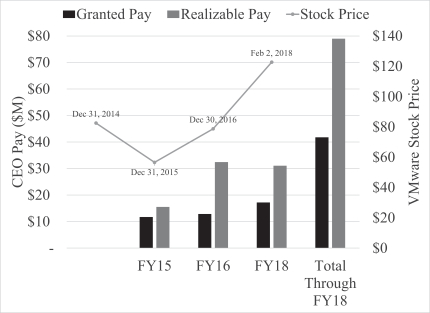
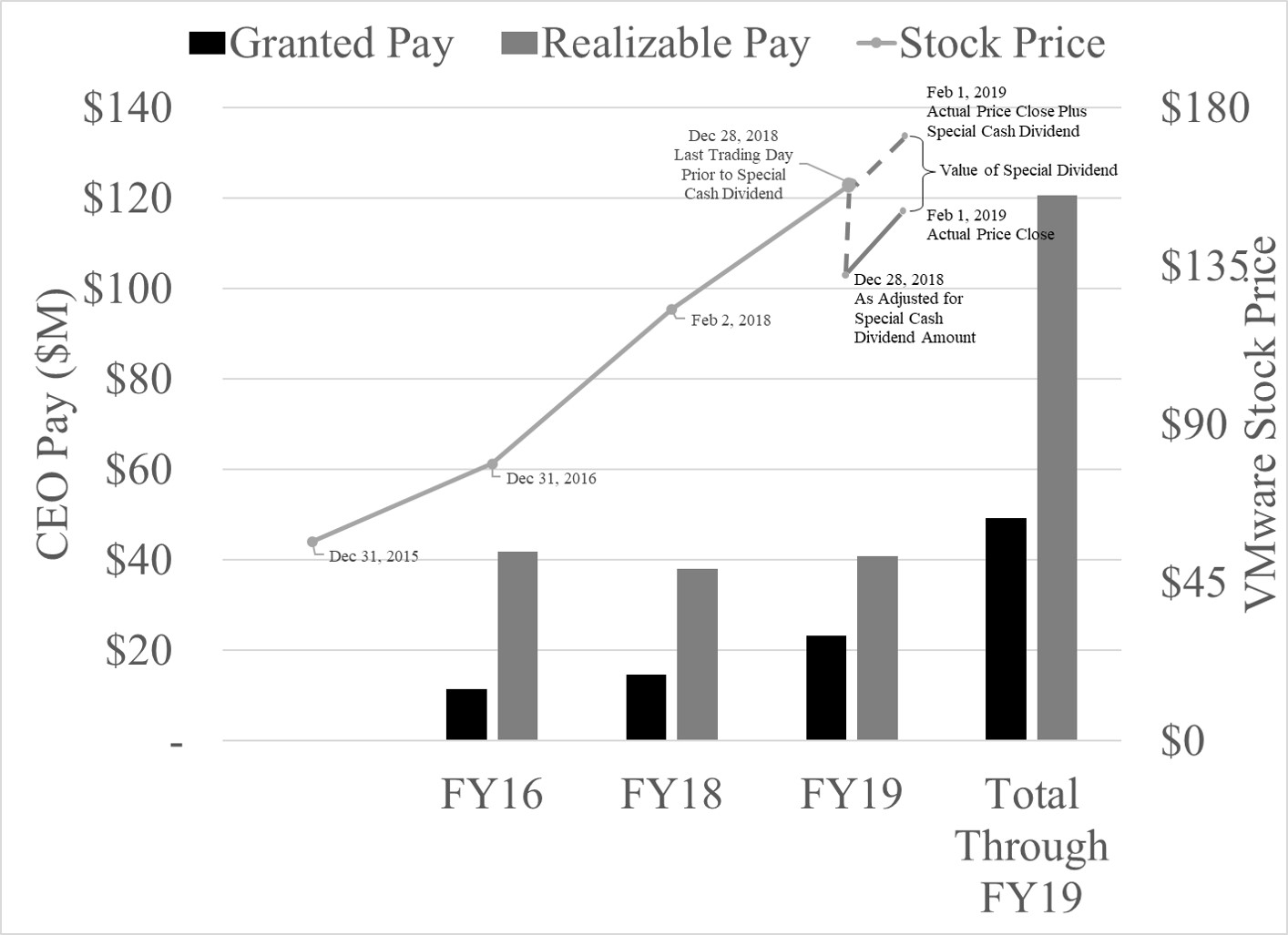
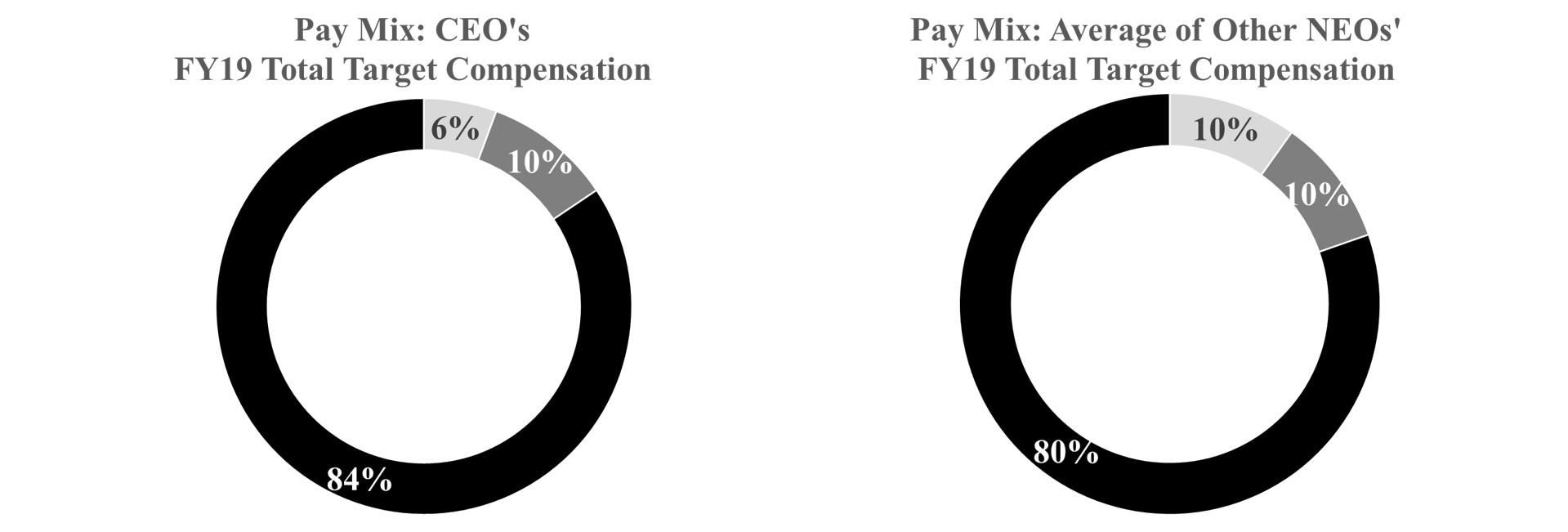


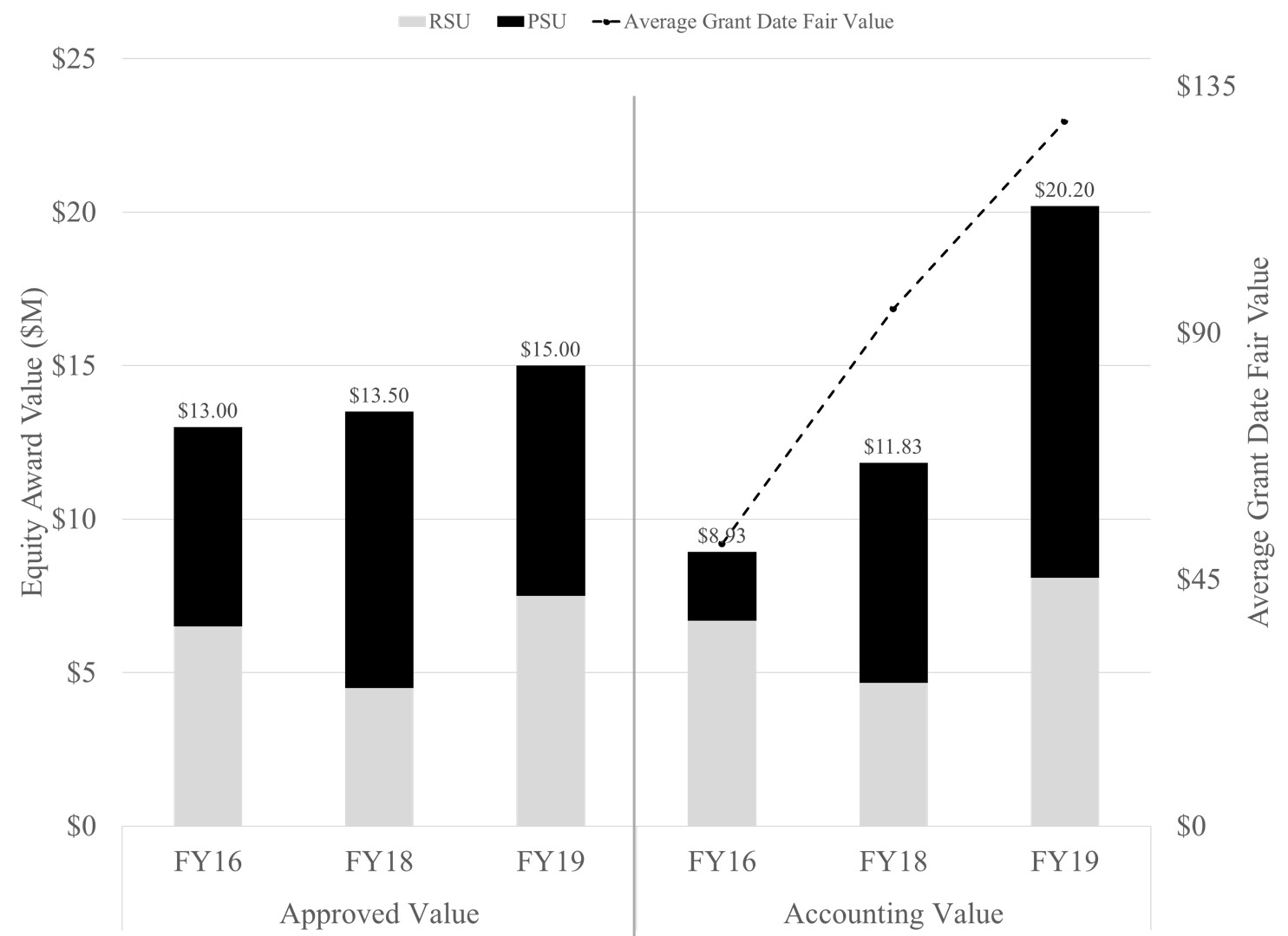 ____________________
____________________